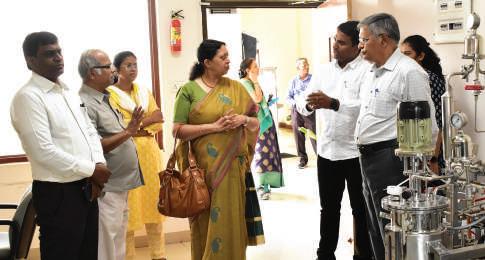
1 minute read
80% REDUCTION IN PLASTIC POLLUTION BY 2040
from Neo Science Hub
by naresh nunna
plastic pollution Third, careful replacement of plastic products with alternatives made from materials like paper or compostable materials can further decrease plastic pollution by 17%. In addition to these measures, we will still need to find safe ways to handle 100 million metric tons of plastics from single-use and short-lived products annually by 2040. To achieve this, we need to set and implement design and safety standards for the disposal of nonrecyclable plastic waste and hold manufacturers accountable for products that release microplastics
Transitioning to a circular economy would result in substantial savings of USD 1.27 trillion, considering costs and recycling revenues. By avoiding externalities such as health issues, climate change, air pollution, marine ecosystem degradation, and associated legal costs, we could save an additional USD 3 25 trillion This shift would also create approximately 700,000 new jobs by 2040, primarily benefiting lowincome countries and improving the livelihoods of millions of workers in informal settings
Advertisement
While the investment costs for implementing these systemic changes are significant, they are lower than the costs of continuing with the current practices Shifting planned investments and imposing a levy on virgin plastic production can help mobilize the required funding However, it is crucial to act promptly, as a five-year delay could result in an increase of 80 million metric tons of plastic pollution by 2040. The report emphasizes that the highest costs in both a throw away economy and a circular economy are operational To address this, producers can implement Extended Producer Responsibility (EPR) schemes, which require them to finance the collection, recycling, and responsible disposal of plastic products.
Internationally agreed policies can overcome the limitations of national planning and business actions. These policies could include criteria for banning certain plastic products, establishing a cross-border knowledge baseline, and defining minimum operating standards for EPR schemes The report also recommends a global fiscal framework to create a level playing field for recycled materials, promote scalability of solutions, and establish monitoring systems and financing mechanisms.
The report encourages policymakers to integrate regulatory instruments and policies that encompass the entire life cycle of plastics, as they can mutually reinforce each other in achieving the goal of transforming the economy. For instance, policymakers can combine design rules for recyclability with targets for incorporating recycled content and provide fiscal incentives for recycling plants
The report also provides specific policy recommendations, such as standards for design, safety, and compostable plastics, minimum recycling targets, EPR schemes, taxes, bans, communication strategies, public procurement guidelines, and labeling requirements.






